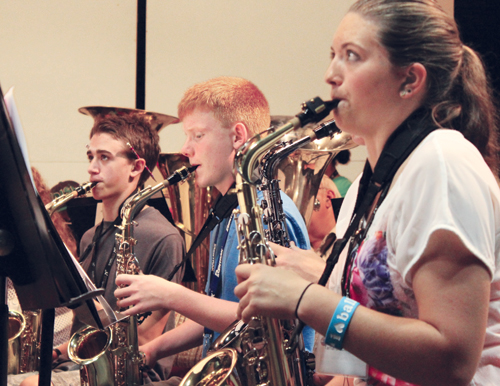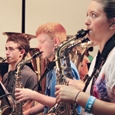
As junior high and high school saxophonists advance, band directors are faced with the prospect of guiding these players to do well in multiple ensembles. For the good of the concert band, it is important to provide proper direction and focus so that the saxophone section develops a mature classic saxophone sound. However, as players move into jazz band or other performance groups, different playing styles or even equipment may be introduced and affect the concert band performance. Here are a few tips on how to balance an appropriate ensemble sound in concert band with encouraging exploration of other musical genres.
Make Notes
Have students keep a journal of all performances and performance styles in which they play. This will show them, in writing, how their performances differ. In addition, recording a list of clinics, band trips, and names of private teachers will also provide good information for college applications, if they choose to continue performing
Learn Classical Solos
The solo compositions students play are important. Pieces should demonstrate both lyrical and technical playing in the classical style. Each work should be challenging, but not to the point that it becomes disheartening.
Play Etudes
When playing etudes, students can work on specific techniques, such as musical phrasing, finger movement, and altissimo to enhance solo performances. Etude practice is also a good way to introduce playing without an accompaniment, especially if the etude has a cadenza. Many etudes have specific notes or fingerings to help the passage sound better or make it easier for the performer. The Rousseau edition of Franz Wilhelm Ferling’s 48 Etudes is a great example of this. He provides helpful fingerings to make passages easier. Students should also sightread new materials, ideally for five to ten minutes every day.
Master Scales First
Because most compositions early in a saxophonist’s development are tonal, students will have a number of opportunities to see how scales fit into the mix. Most students practice scales by learning to play a composition, but it is better to learn scales first. If scales are isolated, students can focus on good tone and clean finger movement.
Students should know all major scales by memory. For reinforcement, practice all scales full range. For example, an F scale should start on F4, go up to the highest note (F6), down to the lowest note (Bb3), and then end on the tonic. Students should also be ready to play a chromatic scale from the lowest note to the highest note. To prevent cross-fingerings, be sure they use the chromatic F# key for F#/Gb and C#/Db major.
A Good Reed
Finding a good reed can be tricky. There are a number of good reed manufacturers today, but the best results will come from professional-level reeds. If the manufacturer offers different professional reed styles, avoid purchasing reeds cut for jazz if they are to be used in concert band. In concert band the saxophone sound should have a warm, centered tone that is not edgy.
If a reed is thicker on one side than the other, it may need adjusting. If a student has a private teacher, that teacher should guide the student through the process. Once students understand how to adjust a reed, they can make every reed in the box play at some level.
To make the box of reeds last for the maximum amount of time, it is recommended to rotate playing each reed. A reed case is also an essential part of caring for the reed. The student can mark the reed case with numbers or the reed itself lightly on the back with a pencil to keep them organized.
An Improved Mouthpiece
The selection of a professional-level mouthpiece is one of the most important investments in equipment a saxophonist can make. Because the right mouthpiece can do so much for the sound, this should be a priority for both student instruments and school-owned saxophones.
Avoid mouthpieces designed for jazz playing. These are usually too open and can be more difficult to control. Young saxophonists might pick up bad habits if they try to make a jazz mouthpiece work, especially in concert band.
Embouchure and Air Support
One of the best ways to correct a saxophonist’s tone in concert band is to work with the student playing on the mouthpiece alone. When playing fortissimo on the mouthpiece, the following concert pitches should sound:
.jpg)
A saxophonist’s embouchure should be formed in the shape of an oval or football with the corners of the mouth in. If this shape is confusing, try forming the letter O. The shape remains constant for each saxophone, with larger saxophones taking a bigger oval shape.
Sometimes students will have a hard time getting a sound out of just the mouthpiece. If this is the case, work with the mouthpiece on the neck, apart from the rest of the instrument. After students feel comfortable getting a solid tone, you can manipulate how firm the embouchure is.
It is important that students take in just the right amount of mouthpiece. The eye cannot always determine this; the best way to discern the correct amount is by ear. Another way to find out how much mouthpiece to take in is by putting a small piece of paper in between the reed and mouthpiece. The place where the paper stops, without forcing it, is where the edge of the lower lip should be.
Make sure the weight of the student’s head rests on top of the mouthpiece. If a student clamps down and rests the weight on the bottom lip, this will produce a pinched, edgy tone.
Blowing through the instrument should feel similar to fogging up a mirror. This idea should help students overcome a pinched tone. Keep in mind that as instrument size increases, air pressure decreases but the needed air quantity increases.
Flexibility is an important part of playing the saxophone. A few exercises to help students gain flexibility are closed-tube exercises (harmonics) and bending palm-key notes down a half step without losing the tone. While playing on the mouthpiece, students should try bending the pitch down from the recommended concert pitch back to the original pitch, going as low as they can without losing the sound. The alto saxophone mouthpiece should sound an A5, so have students try this pitch-bending exercise:
.jpg)
Tonguing Tip
Often saxophone students get in the habit of using a harsh slap tongue. One way to correct this is to have them think of tonguing on the front tip of the tongue to the back tip of the reed. They should think of the tongue flicking the reed, much like a paintbrush. The articulation should be crisp and light, not heavy and harsh. The tongue does not move around the mouth, and the action is very slight. The tongue never produces an accent – all it does is start or stops the reed from vibrating.
Avoid Dropping the Jaw
Some students tend to drop the jaw when playing in the lower register. One of the few times saxophonists should drop the jaw is to play jazz subtone or similar extended techniques, and this should only be attempted after a student has mastered the basic embouchure and can achieve a proper sound in the low register without dropping the jaw.
Establish a Stable Tone
Students like to experiment with advanced techniques like vibrato or altissimo, but it is better to avoid these until students can play with a good, stable tone. Bad habits can be difficult to correct. Unlike the high register of the clarinet, saxophone altissimo is not stable and requires consistent practice until it is easily produced. For altissimo to be played correctly, the student should not reset the embouchure before playing a high note.
Practice Performing
All students should practice performing. The more chances they have to perform in front of people, the more likely it is that they are able to give a consistent performance. This is a crucial step for any performer since it can feel different to play in a pressure situation without stopping. Stage presence should also be addressed, because the audience will form their first impression during the first few seconds of the performance.






